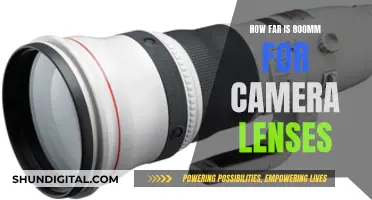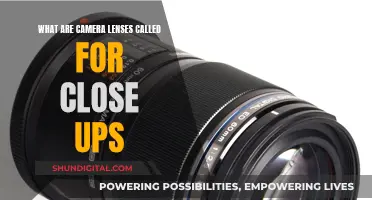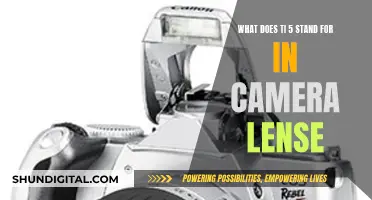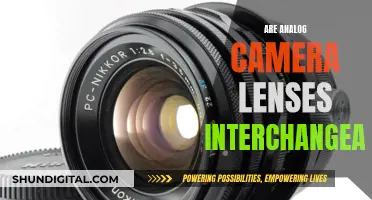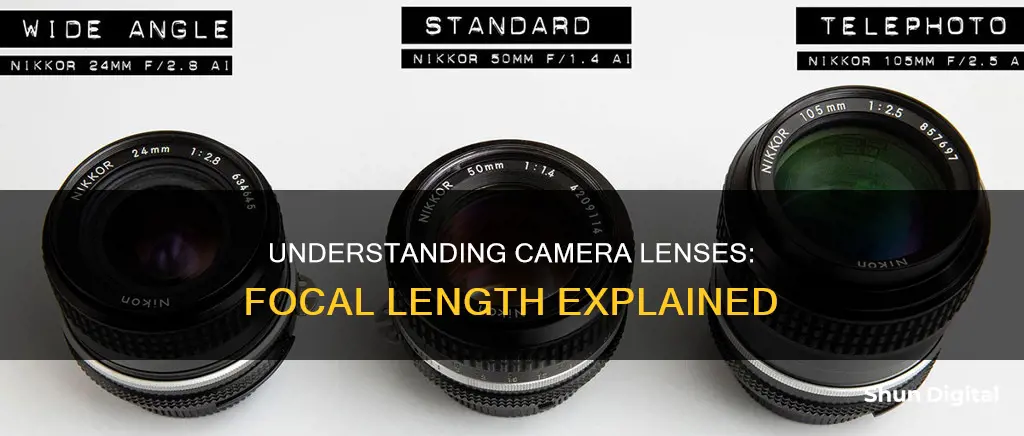
Focal length is a fundamental concept in photography, referring to the distance in millimetres between the optical centre of a camera lens and the camera sensor where light information is recorded. It is not a measure of the physical length of the lens but rather an optical property that determines the angle of view and magnification of the image. Lenses with longer focal lengths provide a narrower angle of view and higher magnification, while shorter focal lengths offer a wider angle of view and lower magnification. This property is crucial for photographers as it influences how much of a scene is captured and the size of the subject in the photo.
| Characteristics | Values |
|---|---|
| Definition | Focal length is the distance, measured in millimetres, between the optical centre of the lens and the camera sensor. |
| Calculation | Focal length is a calculation of an optical distance from the point where light rays converge to form a sharp image of an object. |
| Lens Type | Prime lenses have a fixed focal length, whereas zoom lenses have variable focal lengths. |
| Angle of View | Focal length determines the angle of view of the lens, i.e. how much of the scene will be captured. |
| Magnification | Focal length determines the magnification of the image, i.e. how large individual elements will be. |
| Image Plane | The image plane is where the digital sensor or film plate is found in the camera. |
| Field of View | Focal length is related to the field of view, with longer focal lengths resulting in a narrower field of view and shorter focal lengths resulting in a wider field of view. |
| Image Quality | Longer focal lengths offer higher magnification and sharper images, whereas shorter focal lengths may result in image distortion, particularly around the edges. |
| Lens Size | Prime lenses tend to be more compact and lightweight than zoom lenses. |
| Aperture | Prime lenses also tend to have a larger maximum aperture, which is useful in low-light conditions and for achieving a shallow depth of field. |
What You'll Learn
- Focal length is the distance in mm between the lens's optical centre and the camera sensor
- It's not a measurement of the lens's physical length
- It determines the angle of view and magnification
- Longer focal length = narrower angle of view and higher magnification
- Shorter focal length = wider angle of view and lower magnification

Focal length is the distance in mm between the lens's optical centre and the camera sensor
Focal length is a fundamental concept in photography, and understanding it is crucial for capturing compelling images. It is the distance, measured in millimetres, from the optical centre of the lens to the camera sensor, where light information is recorded. This measurement is determined when the camera is focused on infinity, and it defines the angle of view and magnification of the lens.
The optical centre, also known as the nodal point, is where light rays converge to form a sharp image. When light enters the front of the lens, the internal elements bend and shape it so that it converges into this single point of focus. The lens's focal length is not a measure of its physical length but is instead an optical property. Lenses are named by their focal length, which can be found on the barrel of the lens.
Focal length controls how much of the scene will be captured by the camera and how large individual elements will appear in the image. A longer focal length results in a narrower angle of view and higher magnification, while a shorter focal length provides a wider angle of view and lower magnification. This means that longer focal lengths are ideal for situations where the photographer wants to maintain a distance from the subject, such as in sports, wildlife, or wedding photography. In contrast, shorter focal lengths are commonly used in architectural, documentary, and landscape photography, as they offer a wider field of view.
The standard or "normal" focal length for a 35mm film camera or a full-frame digital sensor is considered to be around 50mm, as it approximates the human field of view. Lenses with focal lengths closer to 50mm are versatile and can be used in almost every genre of photography. Longer focal lengths, typically those above 70mm, are often referred to as "telephoto lenses", while shorter focal lengths are ideal for wide-angle shots.
The choice of focal length depends on the photographer's desired effect and the type of photography they are engaged in. By understanding focal length, photographers can make informed decisions about which lens to use, ultimately enhancing their creative capabilities.
Camera Kit Lenses: Worth the Money or Worthless?
You may want to see also

It's not a measurement of the lens's physical length
When it comes to camera lenses, focal length is not a measurement of the lens's physical length. Instead, it is an optical property of the lens, calculated by measuring the distance from the optical centre of the lens (also known as the "nodal point") to the image sensor or film plane in the camera. This distance is measured in millimetres, and it determines the lens's angle of view and magnification.
The focal length of a lens is determined when the lens is focused at infinity, and it remains a property of the lens itself, regardless of the camera it is attached to. Lenses are named by their focal length, which can usually be found on the barrel of the lens. For example, a 50mm lens has a focal length of 50 millimetres.
While the focal length is not a measure of the lens's physical length, it does impact the physical dimensions of the lens. Longer focal lengths result in physically longer lenses, while lenses with wider views will be physically shorter. However, it is important to note that two lenses can have different dimensions and yet the same focal length, as it is the optical centre that matters, not the physical length of the casing.
The focal length also determines whether a lens is considered wide-angle, standard, or telephoto. Wide-angle lenses have a focal length shorter than 35mm, standard lenses have a focal length between 35mm and 70mm, and telephoto lenses have a focal length greater than 70mm.
Camera Lenses: Tax Benefits and What Qualifies as 'Listed Property
You may want to see also

It determines the angle of view and magnification
The focal length of a camera lens determines the angle of view and magnification. In other words, it dictates how much of the scene will be captured and how large individual elements within the frame will appear.
Focal length is typically measured in millimetres and is calculated as the distance from the point where light rays converge to form a sharp image (the "nodal point") to the digital sensor or film in the camera. It is important to note that this measurement is determined when the lens is focused on infinity.
The longer the focal length, the narrower the angle of view and the higher the magnification. This is why longer focal lengths are often used in wildlife photography and sports photography, as they allow photographers to capture sharp images of distant subjects and make them appear larger within the frame. Longer focal lengths also enable photographers to maintain a greater distance from their subjects, which is ideal for situations where remaining unobtrusive is important.
Conversely, shorter focal lengths result in a wider angle of view and lower magnification. They are commonly used in architectural, documentary, and landscape photography, as they enable photographers to capture a broader perspective. However, shorter focal lengths can also cause distortion, particularly around the edges of the image.
The standard or "normal" focal length for a 35mm film camera or full-frame digital camera is generally considered to be around 50mm, as this approximates the human field of view. Lenses with focal lengths closer to 50mm are versatile and can be used across various genres of photography.
Camera Lenses: Reselling and Buying Used
You may want to see also

Longer focal length = narrower angle of view and higher magnification
The focal length of a lens is a fundamental property that describes how strongly it focuses or diverges light. It is usually represented in millimetres (mm) and is the basic description of a photographic lens. The longer the focal length, the narrower the angle of view and the higher the magnification.
The focal length of a lens is the distance from the optical centre of the lens to the image sensor when the lens is focused at infinity. This distance is measured in millimetres (mm). The longer the focal length, the physically longer the lens will be.
The focal length of a lens determines the angle of view, or how much of the scene will be captured. A longer focal length will result in a narrower angle of view, capturing less of the scene.
The focal length of a lens also affects the magnification of the image. A longer focal length will result in higher magnification, making objects appear larger in the photograph.
Examples of Longer Focal Lengths
Telephoto lenses, with focal lengths between 70mm and 300mm, are a great example of longer focal lengths. They are often used in wildlife photography, as they allow photographers to capture images of animals from a distance without disturbing them. They are also popular for portrait photography, as they allow photographers to maintain a comfortable distance from their subjects.
Super telephoto lenses, with focal lengths of 300mm and beyond, are another example of longer focal lengths. These lenses are often used in sports photography, allowing photographers to capture action from a distance.
In summary, a longer focal length results in a narrower angle of view and higher magnification. This makes longer focal lengths ideal for situations where the photographer needs to maintain a distance from the subject, such as in wildlife or sports photography.
Pentax Cameras and Lenses: Weatherproofing Performance Explored
You may want to see also

Shorter focal length = wider angle of view and lower magnification
The focal length of a camera lens is the distance between the optical centre or nodal point of the lens and the image sensor. This is usually measured in millimetres.
A shorter focal length means that the lens has a wider angle of view and a lower magnification. This means that the lens will capture a larger area, but the subjects within that area will appear smaller. Shorter focal lengths are ideal for sweeping landscape shots or environmental portraits, where it is important to capture the setting as well as the subject.
A lens with a focal length of 24mm, for example, produces a wide angle of view. The area captured is large, but the subject will appear small. This is why shorter focal lengths are used in architectural, documentary, and landscape photography.
Lenses with shorter focal lengths also tend to distort the image, particularly around the edges. This means that photographers need to take care if they want to maintain straight lines.
In contrast, a longer focal length results in a narrower angle of view and higher magnification. The area captured is smaller, but the subject appears larger. Longer focal lengths are ideal for photographing subjects that are far away, such as in sports or wildlife photography.
Troubleshooting a Stuck Camera Lens: A Step-by-Step Guide
You may want to see also
Frequently asked questions
Focal length is the distance measured in millimeters between the optical centre of the lens and the camera sensor. It is not a measurement of the actual length of a lens.
Focal length determines the angle of view—how much of the scene will be captured—and the magnification—how large individual elements will be.
Prime lenses have a fixed focal length, whereas zoom lenses have variable focal lengths. Zoom lenses are more versatile and reduce the need to change lenses, but prime lenses are more compact and lightweight, with larger maximum apertures.
The best focal length depends on the subject matter and situation. Shorter focal lengths have a wider angle of view and are good for landscapes, architecture, and large groups. Longer focal lengths have a narrower angle of view and are more suitable for sports, wildlife, and wedding photography.
A "normal" or "standard" lens is one that gives a similar field of view to the human eye. On a 35mm film camera, this is usually considered to be a 50mm lens, or something close to it (around 35mm to 70mm).



